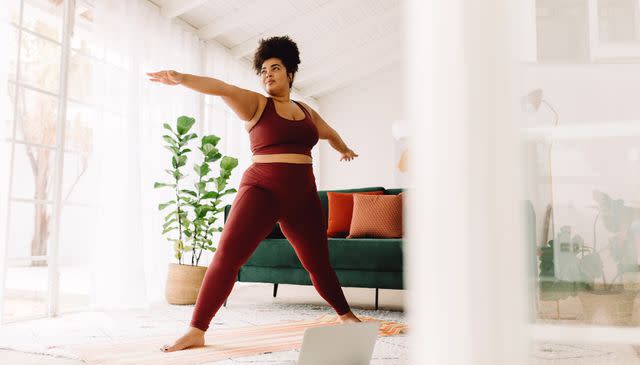4 Types of Exercise That Help Reduce Inflammation
Here are some of the best anti-inflammatory exercises—and the science to back them up.
Inflammation is a word that gets thrown around a lot—and for good reason. When inflammation is chronic (rather than acute), meaning it’s slow, cumulative, and lasting months to years, it can do a number on your health in various ways. For one, long-term inflammation wears down your immune system, which can put you at risk for issues such as cardiovascular disease, cancer, type 2 diabetes, arthritis, and more health conditions.

Julia Amaral/Getty Images
Taking an active role in your well-being and working hard to prioritize good sleep, keep your stress levels low, and eat anti-inflammatory foods (think: cruciferous veggies, berries, pulses, and omega-3-rich fish) can help keep inflammation at bay. And it also has the potential to add years to your life. Another great way to reduce inflammation and boost your immune system: regularly getting some good, old-fashioned exercise.
“All acute exercise induces a low-grade inflammatory response that the body then adapts to, creating a longer-term, anti-inflammatory adaptation, says Stacy T. Sims, PhD, an exercise physiologist and nutrition scientist. “This is why the fitter you are, the less chronic inflammatory markers there are.”
A systematic review of studies in Frontiers in Physiology backs this up, revealing that both moderate and vigorous exercise can elicit an inflammatory response. However, the research does note that "high-intensity exercise, especially when performed with reduced recovery periods, induces a persistent dysregulation of the immune system with increased susceptibility to illness.” This is why it’s so important to take adequate rest days and alternate between vigorous workouts (think: intense HIIT classes) and some lower-intensity, lower-impact movement (stretching, walking, light cycling, etc.).
To reap the inflammatory benefits of exercise and start feeling better in general, try adding one—or all—of these anti-inflammatory exercises into your fitness routine.
:Is Your Lifestyle Too Sedentary? Here Are 8 Signs You're Not Active Enough
Walking
Honestly, going for a good walk is one of the best things you can do for your health. Not only is it free and accessible for almost everyone, but time spent walking offers a ton of good-for-you benefits, including boosting your energy, improving your memory, and kicking stress in the you-know-what. It can also help with inflammation. “It’s now understood that the same chemicals released to regulate inflammation are also released during exercise,” explains Carlos Davila, fitness professional and diversity and inclusion officer for Fhitting Room. “Jogging or power walking for 20 minutes is more than sufficient to reap the benefits of exercise on inflammation.” What’s more: According to research in Brain, Behavior, and Immunity, even just one 20-minute session of moderate exercise on a treadmill (like a brisk walk or jog) decreases the immune cells producing TNF, a key regulator of local and systemic inflammation that also helps improve immune responses.
:7 Easy Ways to Get More Out of Your Walks
Strength Training
Lifting weights, whether light or heavy, is key if you want to protect your body against inflammation and its lasting effects. “Strength training invokes anti-inflammatory responses post exercise,” Sims explains. (Think growth hormone release, as well as cytokines mediating immune responses to exercise.) More specifically, a review of studies in the British Journal of Sports Medicine revealed that: “muscle-strengthening activities were associated with a 10 to 17 percent lower risk of all-cause mortality, cardiovascular disease, total cancer, diabetes and lung cancer.” To reap those rewards, make sure to pump a little iron at least two days per week.
Yoga
Yoga is about more than impressing your friends with a flawless crow pose (though that is pretty impressive!). This movement practice “invites us to tune into the body so we can confront and release latent emotions that we have tucked away,” says Kimberley Copeland, a certified yoga instructor and ordained reverend. A systematic review of 15 studies involving more than 900 participants in Biological Research for Nursing also found that getting bendy can help reduce inflammation across a multitude of chronic conditions, including high blood pressure, chronic stress, cardiometabolic risk factors, and rheumatoid arthritis.
“[Yoga] reduces inflammation not only by improving circulation and steadying the breath, but also by stilling the mind and calming the nervous system, which can reduce triggers for stress-related eating,” Copeland adds. To truly reap the benefits, be intentional about your breath while practicing yoga. “Breathing in and out of the nose helps to kick in the parasympathetic nervous system, which aids in stress regulation and therefore inflammation in the body,” says yoga instructor Hope Elliot, who recommends spinal twists and the pose "legs up the wall" to help combat inflammation.
:8 Ways to Find Free Yoga Classes (Online or In Person)
Rebounding
Looking for a totally new way to get your heart pumping while keeping inflammation at bay? Jumping on a mini trampoline, or rebounding, was super trendy several years ago, but due to the pandemic and a host of celebs doing it (we see you, Goldie Hawn) there’s been a resurgence—likely because there are so many benefits. For starters, the low-impact, high-cardio, anti-inflammatory exercise is more efficient than running, according to research in the Journal of Applied Physiology. Plus, “it drains your lymphatic system,” says Tiffany Marie, certified personal trainer and founder/CEO of Trampoline Trim. “So we’re clearing toxins out of the body while also reducing inflammation.” Rebounding has also been found to improve bone density, better your balance, and reduce pain severity, too.
For more Real Simple news, make sure to sign up for our newsletter!
Read the original article on Real Simple.

